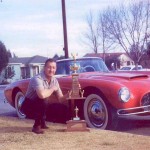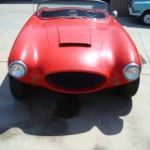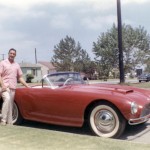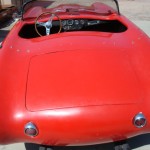
Hi Gang…
I first met M.A. Adams in 2006 when Jon Greuel and I became friends and started to work together to expand what was then the LaDawri website (www.ladawri.com). M.A. Adams stepson, Sandy Grant, contacted Jon the year before as follows:
Date: Sun, 27 Feb 2005
My step father is M A Adams who is shown in the picture of the Meteor. He sold it a few years after he built it. As I was checking around the web, I found your web site with the picture and wondered if you have any additional information as to its whereabouts, or if it is still around. He would love to see it if it still exists. Thanking you in advance for any additional information about the Meteor.
Sandy Grant
M.A (this stood for Malcolm Albert, but he was known by everyone as just “M.A.”) was 86 years old then, of frail body, but sharp and clear mind – and a ball to talk to! Back in WWII, he had been a B-25 pilot. What stories he had to share! This was one cool car guy!
Over 2-3 years, I got to know M.A. and his wife Lillian very well and we spent quite a bit of time on the phone. I even did a conference call with M.A. and Dick Jones (founder/designer of the Meteor) so they could reminisce about their projects so many years ago.
Building the Meteor
M.A.started thinking about building a sports car in late 1953. This was the golden age of building your own car. Glasspar, Lancer , and Skorpion had kicked off this era at
the 1951 Petersen Motorama, and by 1953 many of America’s young men were raring to build and drive one of their own cars. After all…how hard could it be? Back then, stories and magazine covers appeared nearly every month about building your own car.
But building your own sports car was not for the faint of heart. It takes more time than you might imagine. This was before the “kit” days of the 1960’s where you might get a kit that would allow you to bolt a body to a frame and begin assembling the pieces. When you bought a Glasspar, Victress, Allied, Almquist or other body from the 1950’s, all you got was a shell. And if you were lucky, a one page instruction manual. Single sided. Often you’d grab a saw and start cutting on the scribe lines (if the body had scribe lines – which Meteor bodies did not have) where the doors, hood, or trunk might go – unless you ordered a deluxe model where the factory had done this for you. But that was extra bucks then, and bucks were scarce to get.
As you’ve heard me say time and time again, the average build of a sports car in the 1950’s using a fiberglass body took about 2000 hours. Many cars took longer than this (the Jules Heumann Singer Special took over 3000 hours). If you worked 40 hours a week for one year (52 weeks), that’s 2080 hours. Can you imagine what this would cost in modern dollars for labor alone?
No (you say??). Let me give you an example.
If you found a business to build you a car in 2010 or beyond, and they agreed to charge you a reasonable $50 an hour….this means that $100,000 dollars later, you would have yourself a car to drive. Yes…. that’s one HUNDRED THOUSAND dollars in labor. And of course, this did not include the parts, drivetrain, frame, engine, speed equipment or other things to dress it up. Nevertheless, M.A. decided to go forward – he was in his late 30’s when he started. A bit older than most – but more experienced too. This would prove a good omen, for finishing the car.
First, he started building a chassis. Based on measurements given to him by Doc Boyce Smith of Victress (and other employees too, no doubt), he prepared to build a Victress S1A sports car. However, as he was finishing up his chassis modifications, by chance he saw a Meteor outside of a house in Compton, California – probably during the time when the first few Meteors were being built by Dick Jones and his family/friends (Jim Byers, Ray Baird, Russ Hertzog, Larry Jones). Even though it was the same wheelbase, he liked the Meteor body better. Changes were already a ‘comin, and soon one of the first Meteor SR1’s would be born.
M.A. remembered that Dick Jones was going to be moving to Colorado soon, but M.A. talked him into making one more body before he left. Jones delivered it to M.A.’s house – also in Compton – and work began. When he started, M.A. found it interesting that did not have to make many changes to the chassis to fit the Meteor body. He just had to make a “knick” on the back of the frame – and the body slipped on the chassis perfectly. What luck! What he didn’t know is that most of the bodies back then were made to fit a 100 inch wheelbase. No one did it back then, but you could have one chassis and many different bodies to fit it – if you planned carefully.
But what about the drivetrain?
Although he started with a flathead Ford V8 (as you’ll see in the video below), he later changed to a Chevrolet V8 265. This was a fairly common practice back then – especially if you built your own car. The 265 was introduced in 1955 and was the original “Small Block Chevrolet” or “SBC”. In 1955 it had a displacement of 265 cubic inches and was the engine to get your hands on in 1955 and 1956.
As work progressed on the body of the car, M.A. approached several aspects in ingenious ways. He custom fabricated the windshield surround, the grill, the door hinges, hood and trunk hinges, and more more more… He even custom built the convertible top which neatly stowed away when disassembled – into the trunk. You can read about how he did this in the “Technical Specifications” box at the end of the story below.
When designing the Meteor SR1, Dick Jones had not made provisions for a specific windshield. Each person approached it differently. This was later solved by Jim Byers with the Byers SR100 which used the 1953-1955 Corvette windshield and frame. But until this time, Meteor owners would have to be creative.
It should be noted that during the time he built the car, M.A. worked in California as a tool and die maker for an aircraft rivet company. This gave him access to tools, supplies, and others who might be able to help – throughout the week, but after hours of course. M.A. fabricated a chrome metal band that went around windshield – it was the hardest job he did. It took 2-3 weekends – hours and hours of work. After completed, he had it chromed, and it looked like it came from the factory. Boy was he pleased!
During this time, M.A. met another Meteor owner and builder – Edward Tift of Compton California. Edward was building 2 Meteor’s – the first one for himself and the second one to pay for the first one. One smart guy! (his son, Frank Tift later went on to be the first employee of Jim Byers in El Segundo, California, but that’s a story for another day).
Edward was impressed with the hand fabricated concave grill that M.A. made (it looked like it belonged on a Vignale Ferrari), and offered a trade – “I’ll build you a hand carved leather dash for your car if you build another custom grill for my car). Both men were superb craftsman and both men traded their work. Everyone won in this deal.
Color Film of the Build – from the 1950’s:
During the initial build of the Meteor, and later when it was finished, M.A. rolled some color film of the car . We have this film today, and it’s absolutely wonderful. It shows the car being built with the original chassis and Ford Flathead engine – and then quickly skips to when the car was complete. M.A.’s family was kind enough to share this film – now transferred to video – with us, and because of this we can share this with you via Youtube today. It’s about 7 minutes long. I think M.A. would get a kick out of his car being featured on Youtube in this day and age:
[vsw id=”tpJS9Oy4KkQ” source=”youtube” width=”425″ height=”344″ autoplay=”no”]From our discussions, M.A. took his car to two shows “back in the day”. First, he took it to a show in Compton California in 1957 called the “Cavalcade of Cars” wherre it won an award. A reporter at this event took pictures that ended up in a Motor Trend magazine (shown below) and Sports Car Quarterly as well (the first issue of this magazine). This show and noteriety occurred within a year when M.A. had finished his car.
A few years later in 1961, he participated in the Mickey Thompson Auto and Boat Speed Show in Los Angeles California and won one of the top prizes. It was one beautiful sports car, and the trophy was nearly as tall as M.A. Those were the days to get trophies for car shows gang!
Equilogue:
M.A. kept the car thru about 1963 and put 2000-3000 miles on total. Then, he sold his Meteor to a college student in Montebello California around 1963-1964. He did hear back once from the new owner – the front windshield had broken and he called to request information about the type of glass. The new owner had also changed the car from a torque tube (sealed) drive shaft to an open driveshaft. This was better because it no longer leaked (M.A. said it leaked b/c the differential was a bit higher than the transmission). This was the last communication he had with the new owner of his car, and M.A.’s Meteor SR1 Sports Car was never seen again.
I spoke to M.A. and Lillian often and always would call them when we found a new Meteor. I was always hopeful we would find his unique car – one of the best built Meteors back in the 1950’s. But month after month – we didn’t find it. M.A. passed away in early 2008 and my wish to reunite him with his car was never fulfilled.
But later that same year, I got a phone call during one of my research trips and…with a bit of confirmation we had found M.A.’s car! Amazingly, it was still in great shape. It was missing the exquisite grill he had hand fabricated, but still retained the custom windshield surround, the custom trunk and even most of the stow-away convertible top. Wow!. We got the owner going with information he needed and were pleased it was going to a new home. M.A. would be proud, and I was relieved to know his gem of a car had survived all these years.
However, plans soon changed for the new owner who was kind enough to understand our passion for the car. Within a few months, Rick D’Louhy had brought to Florida M.A. Adams Meteor SR1. I couldn’t have been happier for Rick and M.A. on that day.
Currently the car is being stored by Rick with plans soon to begin restoration. The car is in near “survivor” condition and looks like it could be cleaned up and gotten running – with little effort.
I hope you enjoyed the story as much as I had researching it. I think of M.A. everytime I see a photo of one of these beautiful fiberglass cars and on the rare occasions when I’m lucky enough to see one of these rare vehicles in person. I couldn’t have met a nicer car guy along the way.
This story’s for you M.A…..
Geoff
Postscript: April 2nd, 2010:
I heard back from Lillian Adams, M.A.’s wife concerning the story above. Her kind words are below:
Thank you ever so much Geoff – what a wonderful story about M.A. and his car. I am also so proud of both M.A. and also you for giving him this memorial. I know Fern, his first wife is looking down and being proud also. She had been my best friend and how I met M.A. I know I must have told you this but she spent hours with M.A. while he was building his car. Thanks again. Sandy (son) also forwarded this to me to make sure I received it. I am also forwarding it to our daughter, Lori as she felt about M.A. as Sandy did. Lori is now in Bishkek,Kyrgyzatan until June. Her husband is teaching at the American University there until June.
With affection
Lillian
Technical Specifications |
|
| Body |
|
| Designer |
|
| Body Work and Paint |
|
| Upholstery |
|
| Frame |
|
| Suspension |
|
| Engine (make/year) |
|
| Carburetion |
|
| Displacement |
|
| Horsepower (estimated) |
|
| Transmission (type/year) |
|
| Rear Axle / driveshaft (open/closed driveshaft) |
|
| Wheelbase |
|
| Track/Tread (front/rear) (distance between center line of tires) |
|
| Tire Size | |
| Curb Weight |
|
| Windshield |
|
| Taillights | |
| Door Hinges |
|
| Grill |
|
| Dashboard |
|
| Bumpers |
|
| Trunk |
|
| Top Speed (0-60) |
|
| Special Features |
|
Geoff
——————————————————————–
Click on the Images Below to View Larger Pictures
——————————————————————-
- M.A. Adams Started with a 1940 Ford Frame
- Rolling the Chassis and Ford V8 Flathead Drivetrain on the Trailer
- Prepping the Meteor Body For More Work
- Backend of Newly Minted Meteor SR1 Body
- Front of M.A.’s Car with Beautiful Vignale Styled Grill
- M.A. Adams and his Mickey Thompson Trophy in 1961
- M.A.’s Car Today
- M.A. and Lillian Adams – Mother’s Day 2007 (and M.A.’s 89th Birthday)



















This site is protected by reCAPTCHA and the Google Privacy Policy and Terms of Service apply.